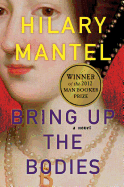
Tudor England during the reign of Henry VIII is a place readers have visited many times--but in the hands of Hilary Mantel, it becomes territory both new and unsettling. In Bring Up the Bodies, the sequel to the Booker Prize–winning Wolf Hall, Mantel weaves a richly textured world that is at once deeply foreign and entirely relevant, coalescing around the single thing that over centuries remains unchanged: the driving passions of people, even those who are kings. Through the eyes of Thomas Cromwell, a man of formidable intellect, the psychological and political complexities of the court are unraveled for inspection. And as ever, Mantel's virtuoso use of language serves to paint images so compelling as to take root in the imagination.
Here the downfall of Anne Boleyn is remade into a chilling suspense story despite its age-old ending. As the characters dance toward their inevitable fates at the chopping block, the reader feels suspense because they do; Thomas Cromwell orchestrates events that lead to Anne's death because otherwise, chances are good that she will do the same to him.
Erotic desire and violent death are a constant, powerful undercurrent despite their subtle deployment. It is almost astonishing the way these books, which do not contain a single sex scene, are so erotically charged throughout. In Wolf Hall, the king was so driven by his desire for Anne to utterly upend the churches of England; a desire so intense that it seems to seep from the pages, evoking a tension that is at once exquisite and palpable. Now in Bring Up the Bodies, the whispers at court subtly insinuate sexual possibilities as everyone is preoccupied with Anne's body: watching for signs of pregnancy, listening for signs of adultery.
The novels are equally driven by the spectre of violent death. Beneath the pageantry and courtesies of Henry's court, Cromwell is constantly aware of the fate of his beloved former master Cardinal Wolsey, as well as that of others who were obstacles to the king. However jovial and kind Henry may seem at times, he is responsible for a succession of heads mounted on pikes--heads of men whose crime was to stand in the way of his marriage to Anne Boleyn. When Henry's desire finds a new focus in Jane Seymour and he begins to wish for an end to Anne, Cromwell sees an opportunity to save himself from falling victim to Anne's schemes. As Cromwell's ruthless plotting escalates, and the body count of the men he aims to destroy increases, a reader's horror at his actions must be intermixed with an awareness that the threat of execution is very real; for Cromwell, it is kill or be killed. Lest we forget, there are those gray severed heads, still rotting. There is the skull of the once-revered Thomas More, now picked clean.
In such a world--where sexuality is pervasive but seldom seen, and death threatens even the most powerful--truth becomes inextricably entangled with imagination. To this day, most historians agree that the case against Anne and her lovers was thin at best. Yet through the use of his imagination, mingled with the conjecture of others, Cromwell fashions a reality in which Anne's adultery is suddenly plausible.
Cromwell imagines Anne's hypothetical motivations so vividly, it is as if his plottings are a parallel to the same mechanism employed by a writer of historical fiction. No one can know for certain the thoughts and feelings of historical figures--but from extant evidence and an understanding of human nature, a writer can extrapolate, inventing an imagined reality that is convincing in every detail. We see this firsthand, as Cromwell sets out to write the story of Anne Boleyn--and use it to bring about her death. --Ilana Teitelbaum

